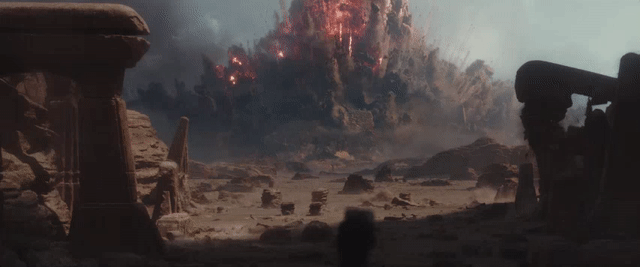Carl von Clausewitz famously wrote, “War is the continuation of politics by other means.” In today’s climate, it would be truer to say, “Star Wars is the representation of politics by other means.” From the echoes of Vietnam in A New Hope and company in the 1970s and ‘80s to the heavy-handed anti-imperialistic tones of whatever those three movies produced from 1999-2005 were, American political climates have been reflected on the Galactic stage. The newest installment, Rogue One, breaks from this mold to offer what is perhaps the most realistic depiction of national security and geopolitics perspective yet: a fractured Rebel Alliance and an Imperial system that is riven by interservice rivalries.

In Rogue One, the ancient Jedi holy city of Jedha is being mined for resources needed to build the Empire’s new super-weapon: the Death Star. Jedha is occupied by a Rebel Alliance splinter group called the Partisans — too extreme for the other rebels — which is in constant warfare with Imperial ground forces. In addition to the Partisans, Jedha is also home to old devotees of the the Force, kicking around in search of something of meaning. Patrols of heavily-armed Stormtroopers accompanied by light armored vehicles, like the TX-225 “Occupier” ground combat tank and the AT-ST, sweep the streets for dissidents. Needless to say, the city is a powderkeg just waiting to go up.

Combat opens in a scene veterans of the wars in Iraq and Afghanistan would recognize all too well – I got a tad twitchy at that part – when an Imperial patrol hits a classic L-shaped ambush in the streets of Jedha. Cloaked men running along the rooftops initiate the ambush with explosive devices and a firefight between Partisan and Imperial forces ensues. A recon patrol from the Rebel Alliance gets swept up in this fight, as do two Force adherents. Jedha gets torn apart by violence as more and more Imperial troops arrive to put down the upstarts and protect the critical transports carrying out the crystal for the Death Star’s laser beam.
Sound familiar? Holy city, home of precious materials being pulled out of the ground that power war machines, irregular warfare, insurgency, IEDs. Yeah, the situation on Jedha could be seen as an allegory to the Middle East conflict at large. The timing of the film was auspicious. At the same time as Rogue One was being released in theaters, negotiations were ongoing between the United Nations, the International Red Cross, Russia, the United States, the Assad government of Syria, and a myriad of Syrian rebel groups. The topic? What to do about the innocent people stuck inside the city of Aleppo. In years of fighting between the Assad government and rebel organizations, Syria has deteriorated into a human rights disaster, with whole sections of cities entirely annihilated.
The Syrian civil war might not have lasted this long but for the intervention of Russia, which provided military aid to the Assad regime. Russian air power and advisors broke the stalemate and began driving the Syrian rebel groups back. Before this, many had assumed that the Russian air force could not sustain long-term operations. Yet over Syria, Russian aircraft have been flying hundreds of sorties at a scale that most did not think they were capable of. While backing Assad, Russia has also been showing off its latest technology, trying out new tactics, and testing its military’s capabilities. And in doing so, has killed tens of thousands of innocent Syrian civilians with unguided cluster munitions, indiscriminate bombing, and intentional targeting of infrastructure. Testing its military, Russia is destroying Syria.
Which bring us back to Rogue One. Grand Moff Tarkin asks Director Krennic to demonstrate the power of the Death Star’s laser, to prove the capability of the weapon system that the Empire had sunk so much of its money into. Krennic complies, destroying the holy city of Jedha in one massive blast – and with it, the Partisans, the devotees of the Force, and thousands of innocent people. The Star Wars universe has made us accustomed to the large-scale devastation of cities and planets, but the destruction of Jedha stands out as more cold-blooded than the rest, precisely because it was destroyed by the very crystals that it provided.

The contrast between what Russia is doing in Syria and the Empire’s destruction of Jedha is, most probably, by chance. Because Star Wars is an epic narrative, we can often find comparisons to our present issues inside it, just as we can with Homer’s Iliad or Virgil’s Aeneid. However, in our current political climate, the image of a Middle Eastern-looking city being blown off the map by a weapon of mass destruction comes with a bit more gravity, because the issue of nuclear weapons being used was on the table this past election year in the United States. We can hope that the image of the destruction of Jedha was merely an unfulfilled fantasy for neocons hoping to see a nuke hit Tehran and not the harbinger of something more dire.
In a more real way, it was a reminder of the intricacies of warfare, foreign policy, and economics: none of the three come in black and white, but the convergence of all three means that innocent people die. Rogue One captured the shifting sands of political and military upheaval that have gripped the Middle East for the past two decades in a way that many conventional pieces have not. And it more than met the qualifications for being a good war movie – in fact, it might have been too good.
Enjoy what you just read? Please share on social media or email utilizing the buttons below.
About the Author: Angry Staff Officer is an Army engineer officer who is adrift in a sea of doctrine and staff operations and uses writing as a means to retain his sanity. He also collaborates on a podcast with Adin Dobkin entitled War Stories, which examines key moments in the history of warfare.




What an odd column. I often like your pieces, but this time, me thinks your Star Wars fanboyism has clouded your judgement. “Star Wars is the representation of politics by other means?” *Star Wars*?
What has always been striking about Star Wars is its childlike total remove from any political commentary. And whilst I agree that Rogue One is the first to bring in some elements of that sort of thing — indeed, it is the first adult Star Wars — you’re really straining to suggest that it’s any sort of “representation of politics by other means.”
I will grant you that the motif, or look if you will, of the Jedha sequence was clearly drawn from the urban insurgency of Iraq circa 2006-07, and that — with a somewhat bizarre inconsistency — the look of the final battle on the archive planet was drawn from Vietnam circa 1968. But that appears to be limited to the styling or visual look — I fear it wasn’t really any deeper than that. Correct me with some examples if you think I’m wrong.
And besides, everyone knows that *THE* pop culture reference for geopolitics isn’t Star Wars …. it’s Game of Thrones.
LikeLike